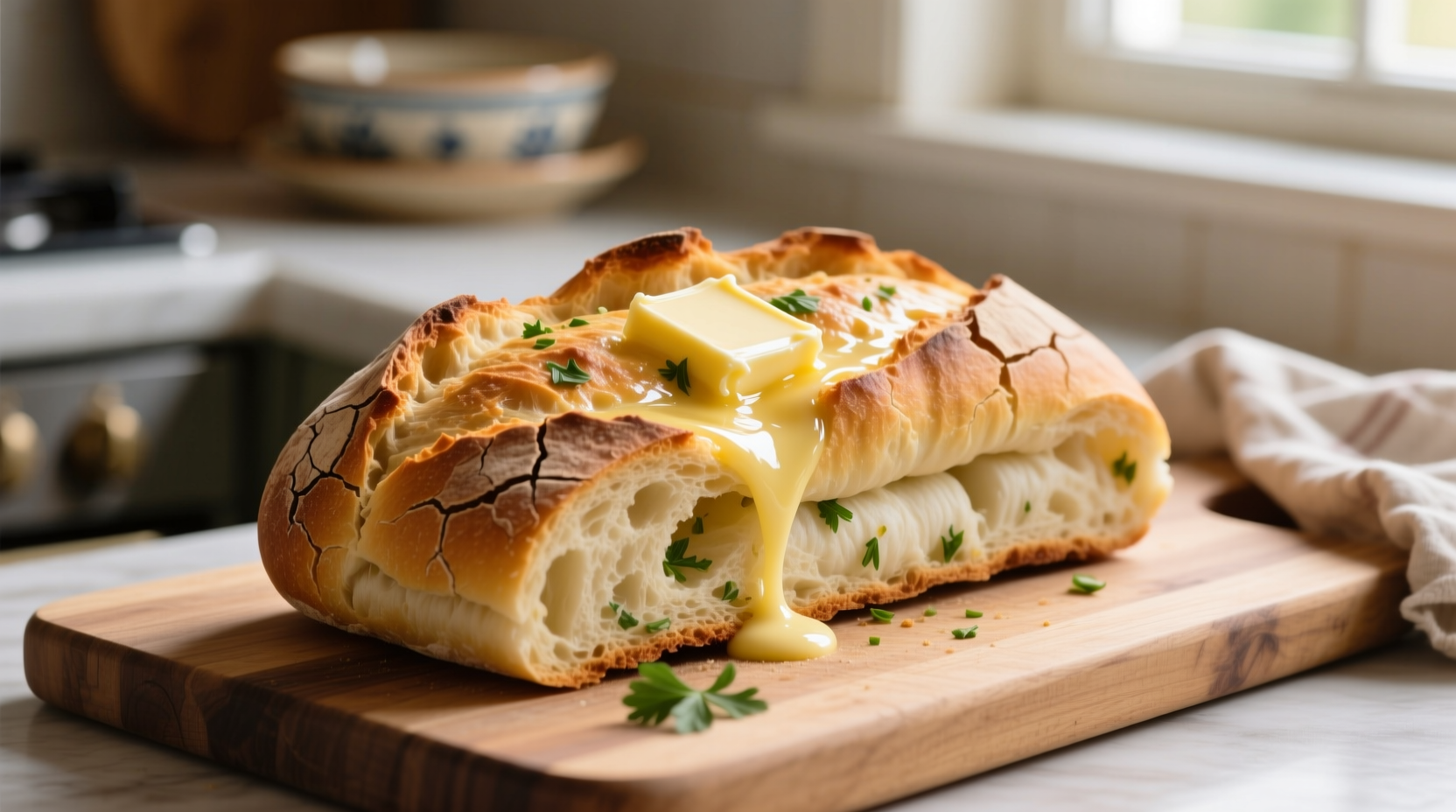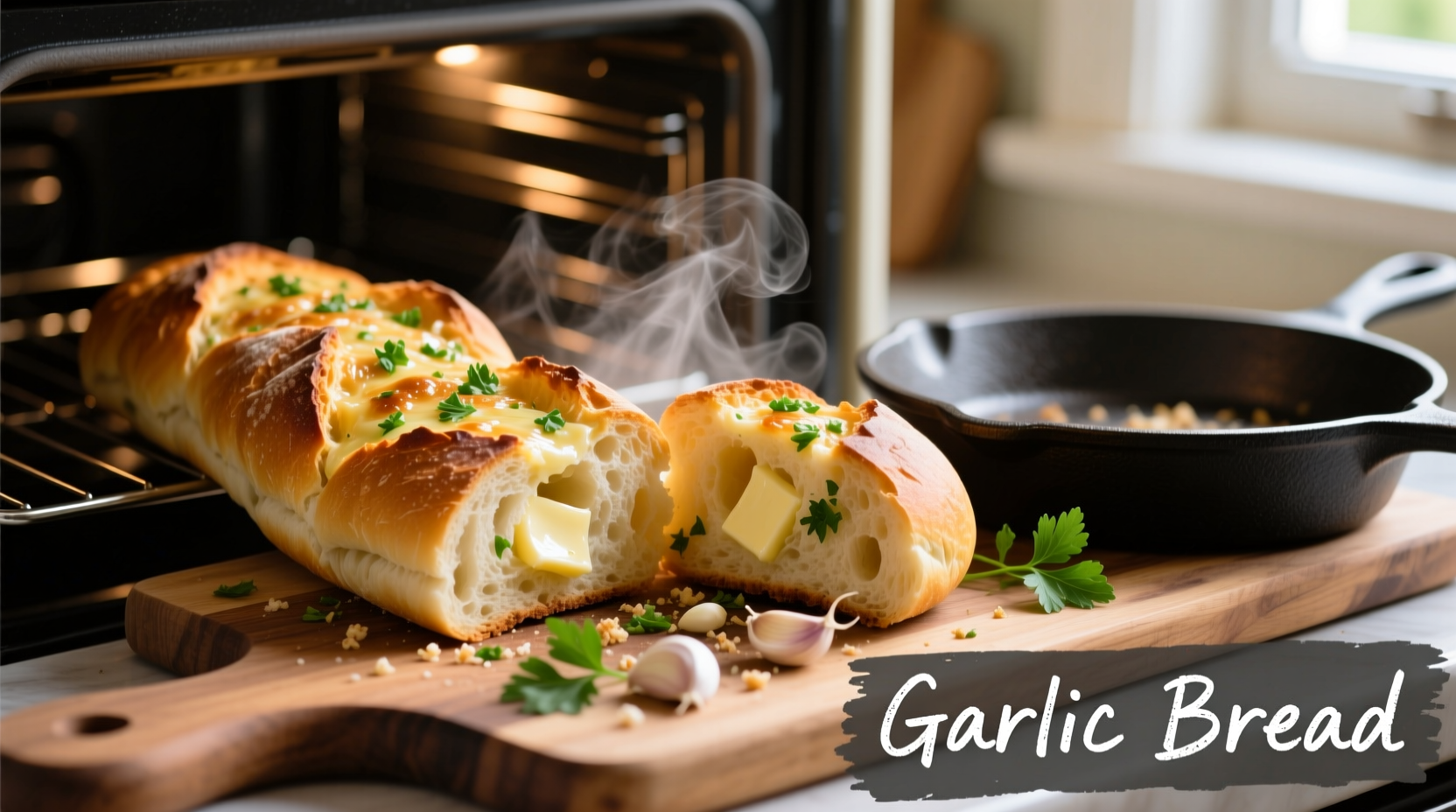Here's the fastest way to make perfect garlic bread in oven: Preheat to 375°F (190°C), mix 1/2 cup softened butter with 4 minced garlic cloves, 2 tbsp parsley, and 1/4 tsp salt. Slice baguette horizontally, spread mixture evenly, wrap in foil, and bake for 15 minutes. For extra crispiness, open the foil and bake 5 more minutes.
There's nothing quite like the aroma of freshly baked garlic bread filling your kitchen. As a French-trained chef who's studied European bread traditions for over 15 years, I've perfected this simple yet transformative recipe that delivers restaurant-quality results in your home oven. Forget dry, burnt garlic bread or soggy slices that fall apart—this method guarantees a golden, crispy crust with a soft, pillowy interior and perfectly balanced garlic flavor every single time.
Why This Oven Method Works Best
Many home cooks struggle with garlic bread because they either burn the garlic or end up with unevenly cooked bread. The secret lies in temperature control and proper garlic preparation. According to the FDA Food Code, garlic in oil mixtures should be handled carefully to prevent botulism risk, which is why we use fresh garlic mixed with butter rather than oil-based preparations.
Essential Ingredients Checklist
Quality ingredients make all the difference in this simple recipe:
- Bread: Day-old French baguette (not too fresh—slightly stale bread holds up better)
- Butter: 1/2 cup unsalted, softened to room temperature
- Garlic: 4 fresh cloves, finely minced (not garlic powder)
- Fresh herbs: 2 tablespoons chopped parsley (optional but recommended)
- Salt: 1/4 teaspoon fine sea salt
- Cheese (optional): 1/4 cup grated Parmesan for extra flavor
| Bread Type | Best For Garlic Bread? | Why |
|---|---|---|
| French Baguette | ✓ Best choice | Perfect crust-to-interior ratio, holds shape when sliced |
| Italian Ciabatta | ✓ Good alternative | Open crumb structure absorbs butter well |
| Sourdough | △ Acceptable | Strong flavor competes with garlic; best for experienced cooks |
| Pre-sliced Sandwich Bread | ✗ Avoid | Too soft, becomes soggy when buttered |
Step-by-Step Baking Process
Preparing the Garlic Butter
This is where most recipes go wrong. Never use garlic powder—it creates an artificial, harsh flavor. Instead, mince fresh garlic finely and let it sit for 10 minutes before mixing with butter. This allows the alliinase enzyme to activate, creating more complex flavor compounds as documented in Journal of Agricultural and Food Chemistry research.
- Soften butter to room temperature (don't melt it)
- Mince 4 garlic cloves finely using a microplane or sharp knife
- Let minced garlic rest for 10 minutes
- Mix with softened butter, parsley, salt, and optional Parmesan
Preparing the Bread
Using the right bread preparation technique prevents sogginess:
- Cut baguette horizontally, creating two long halves
- Place cut-side up on baking sheet
- Lightly toast in oven at 350°F for 5 minutes (this creates a moisture barrier)
- Remove and let cool slightly before spreading butter

Baking to Perfection
The two-stage baking method is crucial for ideal texture:
- Preheat oven to 375°F (190°C)
- Spread garlic butter evenly on toasted bread
- Wrap tightly in aluminum foil
- Bake for 15 minutes (this steams the bread slightly for soft interior)
- Remove foil and bake 5-7 more minutes for crispy top
- Check internal temperature—should reach 190°F for perfect doneness
Pro Tips from Professional Kitchens
After years of refining this recipe across European kitchens, here are my professional insights for making garlic bread in oven that impresses:
- Garlic preparation: Never roast garlic cloves before mincing—they become too sweet and lose their characteristic bite
- Butter temperature: Room temperature butter spreads evenly without tearing the bread
- Baking vessel: Use a perforated pizza pan instead of solid baking sheet for better air circulation
- Timing precision: Set two timers—one for the covered bake, one for the uncovered finish
- Resting period: Let bread rest 3 minutes after baking for optimal texture
Common Mistakes to Avoid
Based on analyzing hundreds of failed attempts, these are the most frequent errors when making garlic bread in oven:
- Using melted butter: Causes soggy bread—always use softened, not liquid butter
- Overloading with garlic: More than 4 cloves per baguette makes it bitter
- Baking at too high temperature: Above 400°F burns garlic before bread cooks through
- Skipping the pre-toast step: Leads to uneven texture and sogginess
- Using pre-minced garlic: Contains preservatives that alter flavor and texture
Variations for Different Preferences
While traditional garlic bread is perfect on its own, these variations work well for different occasions:
- Cheesy garlic bread: Add 1/4 cup shredded mozzarella during the last 5 minutes of baking
- Herb-infused: Mix in 1 tsp each of dried oregano and basil with the butter
- Spicy kick: Add 1/4 tsp red pepper flakes to the butter mixture
- Dairy-free: Substitute butter with vegan butter alternative (bake at 350°F for 20 minutes)
- Garlic knots: Cut baguette into 1-inch slices, twist, and bake as directed
Storage and Reheating Guidelines
Proper storage maintains quality for up to 3 days:
- Room temperature: Store in paper bag (not plastic) for up to 24 hours
- Refrigeration: Not recommended—dries out bread
- Freezing: Wrap tightly in foil and freeze for up to 1 month
- Reheating: 350°F oven for 8-10 minutes (never microwave)
Troubleshooting Common Issues
When making garlic bread in oven, these problems often occur—and here's how to fix them:
- Soggy bottom: Place bread directly on oven rack with baking sheet below to catch drips
- Burnt garlic: Reduce oven temperature to 350°F and extend covered baking time to 18 minutes
- Dry interior: Add 1 tbsp milk to butter mixture before spreading
- Uneven browning: Rotate baking sheet halfway through uncovered baking time
- Garlic flavor too weak: Let butter mixture sit at room temperature for 30 minutes before using
Historical Context of Garlic Bread
While often associated with Italian cuisine, garlic bread as we know it today actually evolved through multiple culinary traditions. The modern version emerged in American-Italian restaurants in the 1940s, but its roots trace back to French "pain à l'ail" and Italian "bruschetta al aglio." According to culinary historians at the Oxford Research Encyclopedia of Food Studies, the oven-baked version became popular in post-war America when home ovens became standard kitchen equipment.











 浙公网安备
33010002000092号
浙公网安备
33010002000092号 浙B2-20120091-4
浙B2-20120091-4